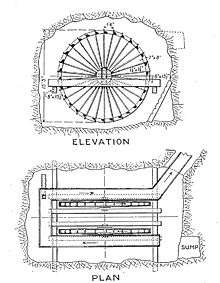Treadwheel

A treadwheel, or treadmill, is a form of engine typically powered by humans. It may resemble a water wheel in appearance, and can be worked either by a human treading paddles set into its circumference (treadmill), or by a human or animal standing inside it (treadwheel). These devices are no longer used for power or punishment, and the term "treadmill" has come to mean an exercise machine for running or walking in place.
History
Uses of treadwheels included raising water, to power cranes, or grind grain. They were used extensively in the Greek and Roman world, such as in the reverse overshot water-wheel used for dewatering purposes. They were widely used in the Middle ages to lift the stones in the soaring Gothic cathedrals. There is a literary reference to one in 1225, [1] and one treadwheel crane survives at Chesterfield, Derbyshire and is housed in the Museum. It has been dated to the early 14th century and was housed in the top of the church tower until its removal in 1947. They were used extensively in the Renaissance famously by Brunelleschi during the construction of Florence cathedral.
Penal treadmills were used in prisons in the early Victorian period in Britain as a form of punishment. According to The Times in 1827, and reprinted in William Hone's Table-Book in 1838, the amount prisoners walked per day on average varied, from the equivalent of 6,600 vertical feet at Lewes to as much as 17,000 vertical feet in ten hours during the summertime at Warwick gaol.[2]
A treadwheel was also used in a submarine in 1851 to pump air to change buoyancy and thus make the vessel dive or rise.
See also
- The Experiment, a horse-powered boat
- Horse mill
- List of historical harbour cranes
- Treadwheel crane
References
- ↑ Matthies 1992, p. 515
- ↑ "Tread Mills", in The Every-day Book and Table Book; or, Everlasting Calendar of Popular Amusements, Sports, Pastimes, Ceremonies, Manners, Customs, and Events, Each of the Three Hundred and Sixty-Five Days, in Past and Present Times; Forming a Complete History of the Year, Months, and Seasons, and a Perpetual Key to the Almanac, Including Accounts of the Weather, Rules for Health and Conduct, Remarkable and Important Anecdotes, Facts, and Notices, in Chronology, Antiquities, Topography, Biography, Natural History, Art, Science, and General Literature; Derived from the Most Authentic Sources, and Valuable Original Communication, with Poetical Elucidations, for Daily Use and Diversion. Vol III., ed. William Hone, (London: 1838) p 755.
Further reading
| Wikimedia Commons has media related to Treadwheels. |
- Animal-powered Machines, J. Kenneth Major. Shire Album 128. Shire Publications, 1985. ISBN 0-85263-710-1
